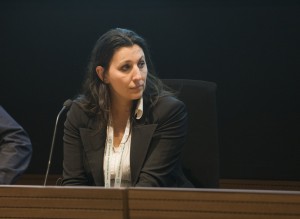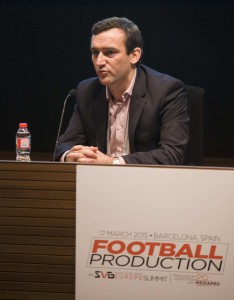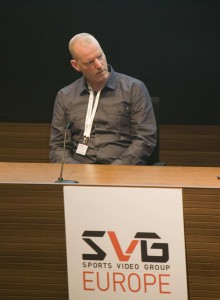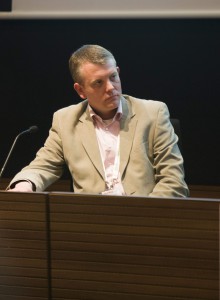Football Production Summit: Match-day production – a view from the top
A high-level panel of speakers from Italy, Netherlands and the UK joined SVG Editorial Director Ken Kerschbaumer on stage in Barcelona to give us an insight into some of the key innovations taking place in those countries to bring us closer to the action on big match day in the top leagues. How do we tell better stories, more cleverly, to engage the viewer? How do we recreate that spine-tingling atmosphere of a raucous crowd in a packed stadium for a top of the table club clash?
Manuela Baraschi is head of Sport Production and Operations at Sky Italia. She said, “we’re in a situation where our competitors have the same matches, so the difference in coverage is one of personalisation. For Sky Italy this is the last season of the current bid.
“In these three years we have introduced exclusive images from the locker room and tunnel, and additional cameras i.e. I-movix with antiflicker and player/coach cameras. We’ve also gone from 10 to 16 cameras coverage for each top match. We use Piero and Viz Libero for tactical analysis, and a studio on-site for top matches with analysts like Vialli, Boban and Marchegiani. For the big matches we also have Twitter from the pitch and so on.
“On match-days,” said Baraschi, “we start and finish with Sky Sport News (SkySport24), covering the pre-match from three hours before kick off and 90 minutes for the post-match. SS24 also covers the training pitch all week long in the build-up to big games. We have also connected eight of the stadiums (11 football teams) by fibre to improve the quality of the feed and we’ve reduced the satellite band from 36 to 24 Mhz, using MPEG-4 DVBS2 uplinks without losing quality but reducing connectivity costs.
“We’re looking at other technologies such as video-stitching for the second screen, but we understand that it is necessary to find a marketing strategy to cover the production costs.
“What would we like? More exclusive matches; more availability from the coaches and players; tactical analysis in the pre-match; and all-week access to the key players,” said Baraschi.
Premier League Head of Production Nick Morgan told us of the three key areas of responsibility in his position. “I’m the person responsible at the Premier League for Premier League Productions, our international production and distribution arm. Secondly I look after our UK broadcasters, almost like an account manager, making sure they get what they need. And the third part is working with our 20 member clubs to make sure they deliver what’s needed to both domestic and international broadcasters.
“In terms of broadcasting we work in a three-year cycle and we’re now in the second year of this one,” said Morgan. “While we’re always looking to enhance our coverage year on year there haven’t been any seismic changes in this cycle. Some of the key differences we’ve brought to our offering over the past couple of years? One, from a domestic point of view, is standardising our offer across all of our clubs. Previously, there were quite a wide variety of approaches among clubs, whether that be camera positions or commentary positions, the level of player and manager engagement and so on. We did a big overhaul of that a couple of years ago, to bring it up to the level we felt was a prerequisite for being part of the Premier League.
“From an overseas point of view,” said Morgan, “we’ve brought a number of new tools into our offering. Perhaps most notable is MARS – multi-angle replay system – which has capitalised on the investment we’ve made to allow us capture any moment of a match from a variety of angles, irrespective of whether the director had cut them to line.
“Remotely at IMG’s Premier League Productions facility in Stockley Park a producer can watch the match and decide for themselves editorially which are the most interesting moments and angles and then compile the together in a clips channel which we distribute around the world,” he explained. “We’re an enabler, providing content for broadcasters, rather than being a broadcaster ourselves — we’re giving remote broadcasters more and more opportunity to behave like a host broadcaster, so their analysis at half time can involve more control of the pictures. Historically, as you all know, sitting on a world feed can be quite frustrating when you don’t know what’s happening when and where.
“In addition to that we now provide a dedicated wide shot at our matches; it’s there, so you don’t have to hope that the host broadcaster goes back to that shot at the right time. You have total control and can act as if you are the host broadcaster. We’re trying to enable international broadcasters to feel like they’re more a part of the action and part of the domestic experience,” said Morgan.
Hearing the heart of the action
“I was delighted to have the opportunity to sit here and talk to all the other broadcasters, because I think we’re all looking for the same goal — which is getting closer to the game,” said Henk van Meerkerk, Head of Production at Fox Sports Netherlands. “And the funny thing is that we’re always talking about cameras; more cameras every time, more 4K, nice graphics and a lot of technology.
“But I think the easiest way to get into the game is audio. We’re not allowed to use full audio [for the Eredivisie]. We can use the microphones of the cameras around the pitch, but we’re not allowed to use the conversations of the referees and we’re not allowed to wire players.
“When I started in 1995 we placed a camera between the benches, and we put a microphone on the camera,” said van Meerkerk. “That microphone is still there, and I would like to show you a clip from the Netherlands: we’re a small market, and probably most of you have never seen football from the Netherlands before!” he told the Barcelona audience. “The clip has two components. The first is emotion. You’ll see a lot of coaches screaming and yelling to referees, and talking to their players. And nobody in the Netherlands cares about this camera. Nobody cares about the audio; it’s just there, and they [the coaches] know it’s there, and they behave the way they normally do.
“Another dimension you’ll see is a high-profile coach and ex-international striker Marco van Basten actually using the camera to explain to the audience why he didn’t like the decision of the referee. He speaks to the camera and also explains to the referee’s boss why they should change certain rules!”
Van Meerkerk then showed the audience a clip of recent action from the Eredivisie, with no censorship whatsoever on the utterances of the managers in the technical zone pitch-side. The startled reaction of the Barcelona crowd, most coming from the larger markets around Europe, suggested that indeed they had never heard anything like it in their own country nor would their leagues even consider allowing such colourful language on air in primetime! “Looking at your reaction to the clip proves to me that this should really be the step to get into the game,” van Meerkerk remarked. Will the big European leagues follow this Dutch example?
Inside Sky Sports’ priority technology list
MIke Ruddell, Head of Technology at Sky Sports UK, took us on a fascinating ride through “a few of the buzzwords and hot topics that are keeping us busy and keeping me awake at night!
“Cloud: Everyone’s got a cloud these days; and we’ve seen some really clever advances such as cloud-connected IP cameras and that kind of thing, and a lot of companies are doing good work around transcoding and delivering through the cloud. But in the broadcast space, I haven’t seen a truly killer application,” said Ruddell. “If you’re just taking your application and putting it in your data centre connected to my studios with a big fat pipe, that’s not what cloud means. The benefits of cloud come with virtualisation and all of those kind of things. So if it can reside in my data centre just as well as yours, then it’s not cloud.
“IP: the benefits of IP for distribution – data connection, files, media, pictures – I think the benefits of that are pretty well understood. The reliability, scalability, integration with IT infrastructure, a lot of that kit already exists. But the questions that are keeping us busy in terms of IP are, where do you draw the line in the production chain from glass to glass? Can we see a world in the future where a Cat-5 cable comes out of a camera and also goes into your set-top box at home? Probably not for a while, but where do you draw the line between that SDI world and the IP world — and in the transitional period do we have to maintain the two things?
“Social, second screen and apps: We know the second screen is here to stay, but the challenge is that there are now so many clever apps and things you can do with your iPad and the second screen that it’s really hard to see the wood from the trees sometimes. There must be a dozen cool new things that come past the desk every day to do with apps and social … but at the same time everyone is really keen on engaging a younger audience so apps and social is the way to go.
“Remote production: it means many things,” he said. “It could just mean bringing a few camera feeds from the OB back to base and cutting the feeds remotely. The opposite end of the scale – will we get there, maybe we shouldn’t – is remote cameras and nobody on-site, with a great big resilient network between the site and base. At Sky we’ve dabbled a bit with remote production; the first event of any scale we did was Sky Sports News operation at the 2012 Olympics where we built a studio on top of Westfield. The IP connectivity worked better than we hoped, but we weren’t fully confident so we double-crewed it and worked remotely and on-site. We’ve seen recently some really cool stuff that Pac-12 Networks have been doing out in California with college basketball: it has proven that the technology is there and it works as long as you’ve got the network between A and B. But depending on what your market is and what country you’re in, and depending on the telco environment, it’s quite hard to make the numbers stack up. You can be sure that if the numbers did stack up already, we’d be doing it a lot more than we currently do.
“Ultra HD: Sky’s position on this is fairly clear. We’re testing, we’re learning a great deal. But there has been no commitment to launching a UK service – we’re just getting our hands on as much kit as we possibly can and putting it through its paces, so that if the trigger is ever pulled, we know in which direction to head. But for us, fundamentally, the reason that trigger has not been pulled is because the wow factor is not there. We’ve ticked the box that says more pixels; we have’t yet ticked the box that says high dynamic range, faster pixels, higher frame rate and SMPTE 2020 colour space.
“I’m not the marketing guy who’s going to have to sell this to customers,” said Ruddell, “but it would be a real challenge to try to sell them UHD-1 this year; and when all those additional features are available, try to sell them another set and another service and another set top box 12 months down the line. UHD is obviously big in everyone’s minds, but for now we’re just testing and ‘watch this space’.
“Virtual and player tracking: There’s a lot of cool stuff we can do now – but one thing we must ask ourselves is, are we just doing all that to impress each other in this room? Does it truly add anything to the experience? Among the things you really need to consider are improved efficiencies, in terms of people, workflows or processes. These days, with our merger with Sky Deutschland and Sky Italia, are there any efficiencies we can realise there? Quite tricky, as we tend to cover different sports in different ways… But at the end of the day, none of these cool things are going to make it onto primetime unless they either make us money; save us money; or really add something to the editorial storytelling of the show.
“Connectivity: One project we’re running at Sky is improving our connection to the telco providers, and installing a secure platform between Sky Studios and the outside world. We’ve called it the OB Data Gateway. This is Sky-managed IP, so we can effectively buy any IP-delivered service from BT or any other telco around the world, as a managed service with extremely high SLAs which is where we put our premier circuits: we don’t put that on a dodgy bit of internet with a five hundred quid video-to-IP encoder. If we can just rent the bandwidth we can just manage all these services ourselves.
“We have already saved money here,” said Ruddell. “Some of the secondary video circuits for Formula 1 – the on-boards and so on – moving to VOIP comms instead of ISDN is saving cash. Also on F1, remote editing to save us taking huge amounts of storage out on the road. Lower quality reverse feeds to our regional offices. Cellular and ENG contributions come through this system. Giving staff mobile remote data access saves them buying expensive SIM cards when they’re out of the country. And on the Premier League itself we’re delivering pan-cams back to the studio, a locked off camera not pointing at the pitch, showing the reaction of fans which is used for our Soccer Saturday production.
“In the old world,” said Ruddell, “if we wanted all our ancillary services at base available to us on a production we had to take them out on the road, meaning bigger OBs and more kit on the trucks. Instead of one centralised system we had to have 20 trucks. So, where we’re heading now, if we think about it as a very clever firewall, it will enable us to effectively not just connect any computer at Sky Studios to any computer on the road but it will let you connect any service run by any user on any computer in the world to any service on a computer back in Sky Studios.
“It’s much more grand than an IP address on a box-to-box level, it’s about services. What it means is that all of that stuff can be running either on the trucks or in Sky Studios – in theory, there’s no difference. We haven’t even scratched the surface of what we could do with this. All of the cool buzzword stuff we talked about before, I see as being enabled by this data gateway platform of the future,” Ruddell told the Barcelona audience.




